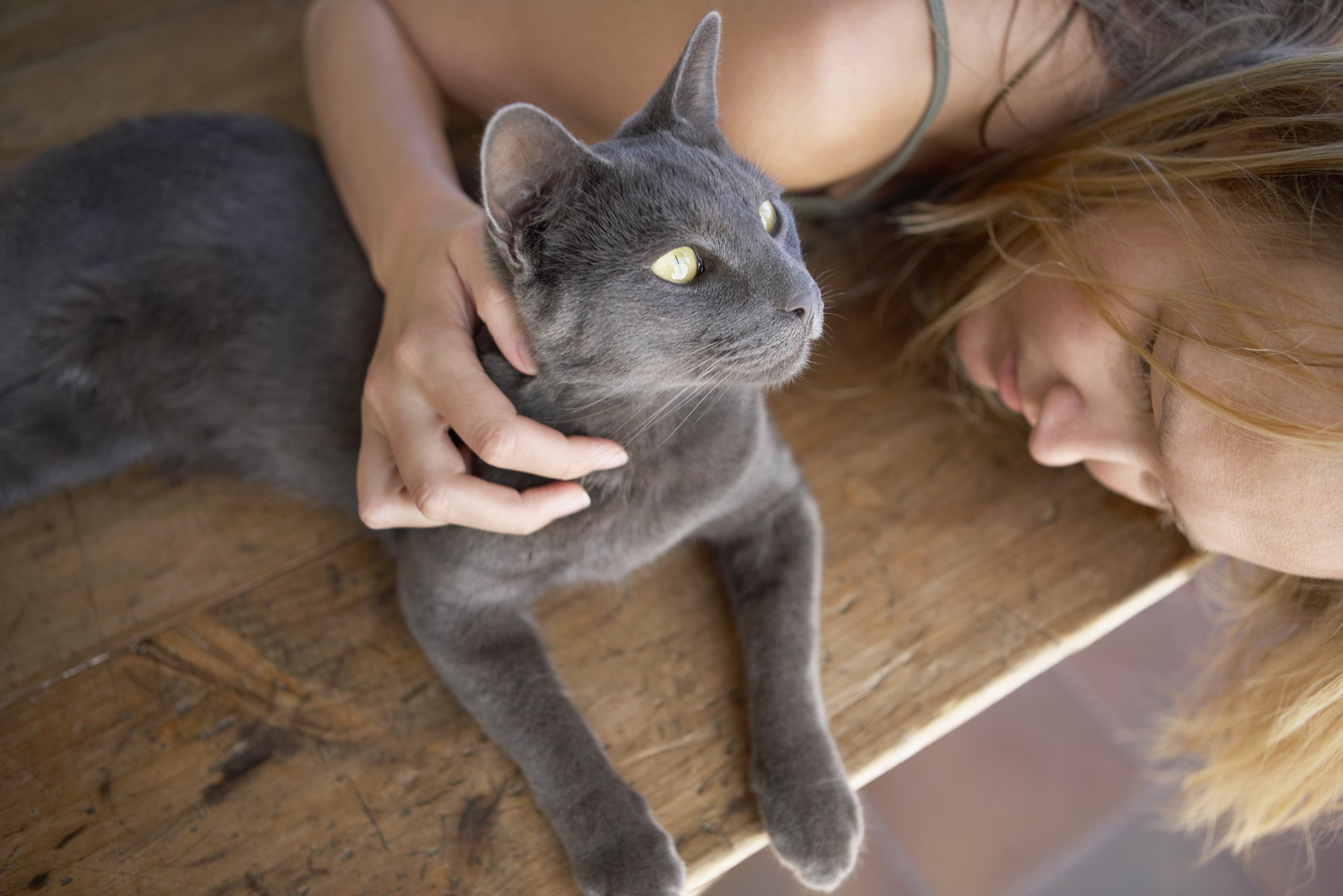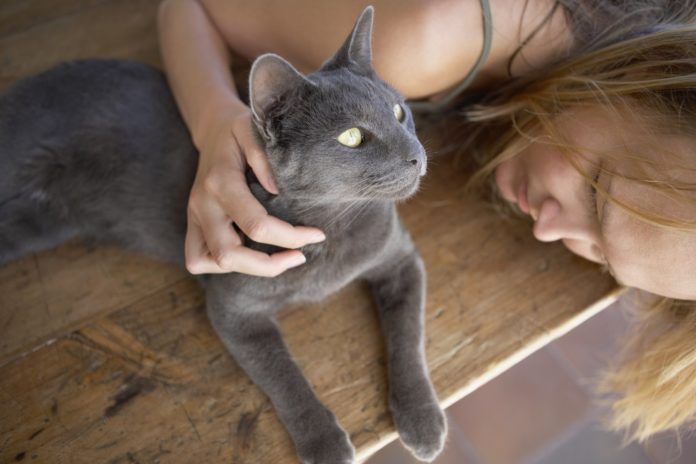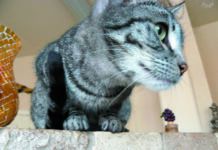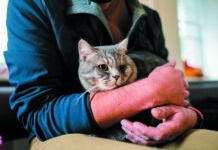As a feline veterinarian, I perform dozens of physical examinations every week. Every veterinarian performs the physical exam in his or her own style, making sure to evaluate all body systems thoroughly. Assessment of the lymph nodes is unquestionably a part of every veterinarian’s physical exam.
The lymphatic system is an arm of the immune system that plays a role in the development of the body’s immune response. Lymph is the fluid that flows through the lymphatic system, and it is rich in protein and white blood cells. Cells of the immune system circulate throughout the lymphatic vessels in the body. Lymph nodes are small, oval-shaped organs that make up part of the lymphatic system.


thinkstock
As lymph flows through the lymphatic vessels, it passes through at least one set of lymph nodes — and often several sets — before ultimately emptying into the general circulation where it mixes with blood. The lymph nodes are the major sites in the lymphatic system where the immune cells gather.
Lymph nodes have a distinct anatomical structure, consisting of an outer portion called the cortex, and an inner portion called the medulla. The cortex contains large numbers of lymphocytes, often arranged in clusters (follicles). There are two distinct types of lymphocytes found in lymph nodes: T lymphocytes and B lymphocytes.
The B lymphocytes are responsible for producing antibodies, a process called “humoral immunity.” Once stimulated, T lymphocytes are involved in a process called “cellular immunity” (the details of which are beyond the scope of this discussion). The medulla contains lymphocytes as well as many other cells of the immune system. The entire lymph node is surrounded by a capsule comprised of connective tissue.
When lymphocytes proliferate
The immune system’s job is to protect and defend the body against harm by mounting an attack against invading substances (antigens). When an antigen invades the body and makes its way to the lymphatic system and eventually to the lymph node, it stimulates a discrete population of lymphocytes in the node. This causes those lymphocytes to proliferate and transform (or become activated). As noted above, activated lymphocytes may produce antibodies that neutralize the antigen, or the lymphocytes may become involved in more complex “cellular” immune responses.
When these lymphocytes proliferate, lymphadenopathy develops. Lymphadenopathy is the medical term for an increase in lymph node size. Stimulation of the immune system is a common cause of lymph node enlargement, and cancer is an equally common cause.
Lymphadenopathy is sometimes discovered during a routine examination of the cat. Occasionally, a cat owner will bring a cat to the veterinarian because of clinical signs related to the lymph node enlargement — for example, difficulty swallowing due to enlarged retropharyngeal lymph nodes, which are located at the back of the throat. (See sidebar on page 8.)
Sometimes an owner will bring a cat to the veterinarian because they’ve detected a lump — which turns out to be an enlarged lymph node — while patting or stroking the cat.
Why age is important
The age of the cat is important when considering the significance of lymph node enlargement. Kittens and young cats are exposed to a variety of antigens early in their lives, and an increase in lymph node size is an expected response by the immune system. As cats mature, lymph node size usually decreases and the nodes often become more difficult to palpate in older animals. However, in geriatric cats or cats that have lost weight due to illness, the loss of body fat around the lymph nodes may make the lymph nodes appear more prominent than expected.
Unfortunately, cancer is a common reason for lymph node enlargement. The size and texture of the lymph node may give clues in this regard. Enlarged, firm, painless lymph nodes that are freely moveable are usually associated with primary lymph node cancer, i.e. lymphoma. Very hard lymph nodes are more suggestive of metastatic cancer, i.e. a cancer arising in another site in the body that has spread to that lymph node.
Size and location
The degree of enlargement may offer some clues as to the cause. Marked lymphadenopathy (when the lymph node is five to 10 times the normal size) most often occurs with a lymph node abscess (a severe bacterial infection) or with lymphoma; metastatic cancer rarely causes lymph node enlargement of this magnitude.
The location of the lymph node enlargement should also be considered in the patient’s evaluation. If one lymph node is enlarged — or one regional group of lymph nodes is enlarged — the vet will carefully evaluate that area of the body for evidence of inflammation, infection or cancer. For example, if the right submandibular lymph node (the node just below the jaw) is enlarged, the right side of the mouth will be examined carefully. A tooth root abscess involving a tooth on the right side, for example, could cause this nearby lymph node to be enlarged. However, if all of the lymph nodes involving the head region are enlarged, a more diffuse illness involving the head — such as an upper respiratory infection — would be something to consider.
How a diagnosis is made
Obtaining a diagnosis in cases of lymph node enlargement may require a variety of tests, including blood and urine analysis, X-rays and ultrasound. Ultimately, a definitive diagnosis often requires obtaining a sample of cells from the node itself. This is usually achieved either by aspiration cytology, or by surgical biopsy.
Aspiration cytology is a procedure in which a needle — attached to a syringe — is inserted into the lymph node. Suction is applied to the syringe so that cells from the lymph node are aspirated or sucked into the hub of the needle. The contents are then sprayed onto a microscope slide and are sent to the laboratory for interpretation. The advantage of this procedure is that it is fairly non-invasive and inexpensive. A disadvantage is that the aspirate may not yield enough cells to make a diagnosis. Only positive findings are diagnostically useful. Unfortunately, the absence of abnormal findings in an enlarged lymph node means that the diagnosis is still unresolved.
Biopsy of the lymph node is the definitive diagnostic test in evaluating lymph node enlargement. Depending on the size and location of the node, either the entire node is removed (this is called “excisional biopsy”), or a small piece of the lymph node is removed (this is “incisional biopsy”). The biopsy specimen is then evaluated by a pathologist. Treatment is based on the biopsy results: infections are usually treated with antimicrobials; cancer is treated by chemotherapy, surgery, radiation, or a combination of these. Lymph node cancers can often be treated effectively, and infections typically respond well to antibiotics. In either case, the most important thing for you as the owner to do is to check your cat thoroughly for abnormal swellings every couple of months or so, particularly as she gets older, and see your veterinary if you find anything suspicious. —Arnold Plotnick, DVM, DACVIN





Hurrah! After all I got a webpage from where I be able to
truly take helpful information regarding my study and knowledge.
Yes “Hi!”
Literally hours of my internet searches only revealed either incredibly pedestrian explanations that are so vague and unspecific as to be totally unhelpful.
OR
Scientific study abstracts that proved confusing to non-professionals: pet owners.
Thank you Catnip estaff for providing useful, helpful information.
A bout a year ago a friend of mine had surprised me with a beutyfull gift that I could not refewsed to except in to my life.hes a beutyand he is a full growing adult male cat.with m adult male felion.he and I had bonded a great dill and I love this cat with all my heart.and I know test that and like any cat owner I want the best for my cat and it came to concerns that I know test a large hard knot on his left side of his limphnode.i know my cat is in need my cat is in need for a great check up and medical etention.and I am now afraid that I I have a very low fix income and I don’t have insurance.im afraid I won’t be able to get the help and care for my cat that I know he’s deserves.what can I do to get my cat to get the help that he needs is there any way that I can defensed this situation.and can you please help us thank you sincerely Shirley ann
Thanks for the article. WARN PEOPLE that Conenia isn’t going to work if you can give pills or fluid-USE THAT route if first 2 week shot doesn’t have an effect. My vet likes it but for NON pill pocket pets may ONLY work for weak infections.
I picked up my coz cat from New Jersey in November-he ignored diabetes problem and dropped dead in doctors parking lot. I found that his 12 year old cat hadn’t been to vet in 3 years. My vet was booked-so another vet did a non complete blood work at another vet and normal shots.
Jordi Cat was underweight, poor coat and smelled odd. I immediately put him onto top quality food and methimazole 5 mg 2 x a day. I found submandibular swelling, and booked to MY vet in January and found that his blood work had pancreatic problems. So in Feb alter to Felimazole 2 x 5 mg, 5 mg predisone 1 x day. His submandible had swelling as well as thyroid-small in size but evident. I found in June the damned thing is increasing in size although the cat seemed in great shape-coat great-the smell of the cat no longer odd. All three vets and staff couldn’t seem to pick up what I meant although they did smell for kidney/mouth/infection smells.
(I told the vet he smelled differently than previous 60 years of cats-not ketone or infection smell. I mean how each cat smells individually. I mean the cats smell when you sniff the brush or comb. For instance-my fathers hairbrush smelled different than moms-and now at 67 MY hairbrush also smells like his since I was 62. NOT like my sisters or brothers hair brushes when I borrow them. People can smell difference between pot and smoke without opening a bag, or khat or bush meat in cargo. Great weapon for a retiree USDA APHIS PPQ officer).
After 6 mos on RC kd, Hills KD and HIS grain free highly digestible Nutro the odd smell is gone and his skin and coat are finally good.
BUT AFTER now 3 x 2 week and another 1 x 2 wk on Convenia I insisted this week after the THIRD bloodwork test we alter onto ORAL CLAVAMOX (amoxicillin and clavulanate potassium oral suspension 15 ml 1 ml oral 2 x per day. I distrust that antibiotic encapsulated infections.
BUT after 3 x 2 weeks Convenia shots, a needle aspiration finding nothing a finishing in June 22 the sub mandible lyph gland was enlarging-so back in June 25 asking for ANOTHER blood test and another Con
Dünya, insanın düştüğü maymun ruhunun yuvası olsun diye, şeytan çırağı ideoloji ve politika mimarlarınca, hamur gibi yoğruluyor. Sezai Karakoç
Ya olduğun gibi görün, ya göründüğün gibi ol.